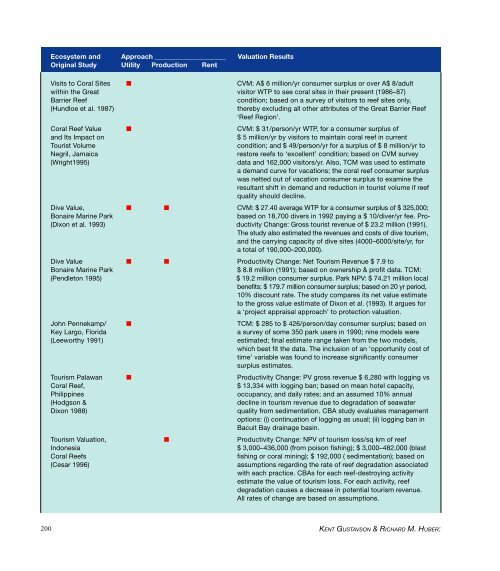You also want an ePaper? Increase the reach of your titles
YUMPU automatically turns print PDFs into web optimized ePapers that Google loves.
Ecosystem and Approach _____________________ Valuation Results<br />
Original Study Utility Production Rent<br />
Visits to <strong>Coral</strong> Sites ■ CVM: A$ 6 million/yr consumer surplus or over A$ 8/adult<br />
within the Great visitor WTP to see coral sites in their present (1986–87)<br />
Barrier Reef<br />
condition; based on a survey <strong>of</strong> visitors to reef sites only,<br />
(Hundloe et al. 1987)<br />
thereby excluding all other attributes <strong>of</strong> the Great Barrier Reef<br />
‘Reef Region’.<br />
<strong>Coral</strong> Reef Value ■ CVM: $ 31/person/yr WTP, for a consumer surplus <strong>of</strong><br />
and Its Impact on<br />
$ 5 million/yr by visitors to maintain coral reef in current<br />
Tourist Volume<br />
condition; and $ 49/person/yr for a surplus <strong>of</strong> $ 8 million/yr to<br />
Negril, Jamaica<br />
restore reefs to ‘excellent’ condition; based on CVM survey<br />
(Wright1995)<br />
data and 162,000 visitors/yr. Also, TCM was used to estimate<br />
a demand curve for vacations; the coral reef consumer surplus<br />
was netted out <strong>of</strong> vacation consumer surplus to examine the<br />
resultant shift in demand and reduction in tourist volume if reef<br />
quality should decline.<br />
Dive Value, ■ ■ CVM: $ 27.40 average WTP for a consumer surplus <strong>of</strong> $ 325,000;<br />
Bonaire Marine Park<br />
based on 18,700 divers in 1992 paying a $ 10/diver/yr fee. Pro-<br />
(Dixon et al. 1993) ductivity Change: Gross tourist revenue <strong>of</strong> $ 23.2 million (1991).<br />
The study also estimated the revenues and costs <strong>of</strong> dive tourism,<br />
and the carrying capacity <strong>of</strong> dive sites (4000–6000/site/yr, for<br />
a total <strong>of</strong> 190,000–200,000).<br />
Dive Value ■ ■ Productivity Change: Net Tourism Revenue $ 7.9 to<br />
Bonaire Marine Park<br />
$ 8.8 million (1991); based on ownership & pr<strong>of</strong>it data. TCM:<br />
(Pendleton 1995)<br />
$ 19.2 million consumer surplus. Park NPV: $ 74.21 million local<br />
benefits; $ 179.7 million consumer surplus; based on 20 yr period,<br />
10% discount rate. The study compares its net value estimate<br />
to the gross value estimate <strong>of</strong> Dixon et al. (1993). It argues for<br />
a ‘project appraisal approach’ to protection valuation.<br />
John Pennekamp/ ■ TCM: $ 285 to $ 426/person/day consumer surplus; based on<br />
Key Largo, Florida<br />
a survey <strong>of</strong> some 350 park users in 1990; nine models were<br />
(Leeworthy 1991)<br />
estimated; final estimate range taken from the two models,<br />
which best fit the data. The inclusion <strong>of</strong> an ‘opportunity cost <strong>of</strong><br />
time’ variable was found to increase significantly consumer<br />
surplus estimates.<br />
Tourism Palawan ■ Productivity Change: PV gross revenue $ 6,280 with logging vs<br />
<strong>Coral</strong> Reef,<br />
$ 13,334 with logging ban; based on mean hotel capacity,<br />
Philippines<br />
occupancy, and daily rates; and an assumed 10% annual<br />
(Hodgson &<br />
decline in tourism revenue due to degradation <strong>of</strong> seawater<br />
Dixon 1988)<br />
quality from sedimentation. CBA study evaluates management<br />
options: (i) continuation <strong>of</strong> logging as usual; (ii) logging ban in<br />
Bacuit Bay drainage basin.<br />
Tourism Valuation, ■ Productivity Change: NPV <strong>of</strong> tourism loss/sq km <strong>of</strong> reef<br />
Indonesia<br />
$ 3,000–436,000 (from poison fishing); $ 3,000–482,000 (blast<br />
<strong>Coral</strong> <strong>Reefs</strong><br />
fishing or coral mining); $ 192,000 ( sedimentation); based on<br />
(Cesar 1996)<br />
assumptions regarding the rate <strong>of</strong> reef degradation associated<br />
with each practice. CBAs for each reef-destroying activity<br />
estimate the value <strong>of</strong> tourism loss. For each activity, reef<br />
degradation causes a decrease in potential tourism revenue.<br />
All rates <strong>of</strong> change are based on assumptions.<br />
200<br />
KENT GUSTAVSON & RICHARD M. HUBER:


















